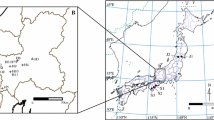Abstract
Morphological and pollen studies were made for the collections belonging toCalamagrostis langsdorffii, C. Sachalinensis, C. longiseta, C. nana and various intermediates between these species from central Honshu, the chromosome numbers of which were reported in a previous paper (Tateoka, 1976). Additional collections made from the Akaishi Range in 1976 were also subjected to the present work. The intermediates showed 0%, or nearly 0%, pollen stainability and a mosaic of morphological features of putative parental taxa which can be estimated to occur for F1 hybrids. This estimation was sustained by a comparison with the pattern of character expressions for the artificially raised F1 hybrids of various European species ofCalamagrostis as reported by Nygren (1962). These results as well as field observations strongly suggested that the intermediates may be wholly or almost wholly F1 hybrids. The hybrids were sometimes found in abundance within a limited area, but seemed to have little capacity to migrate from the places where they originated. The following combinations, which were not previously recorded, were disclosed:C. longiseta×C. sachalinensis, C. langsdorffii×C. nana, C. langsdorffii×C. longiseta, C. longiseta×C. nana. Possibilities of introgression in these hybridizing species were discussed. The hybrids were tetraploids except one hexaploid which was discovered in a mixed population ofC. nana, C. longiseta and their putative F1 hybrids at the tetraploid level. The hexaploid in question, which seemed to have resulted from the participation of an unreduced gamete, was very similar morphologically toC. nana subsp.hayachinensis distributed in the mountain far distant from central Honshu. Geographical distributions of the hybrid plants were surveyed through examination of the herbarium specimens.
Similar content being viewed by others
References
Chase, A. andC.D. Niles. 1962. Index to Grass Species. G.K. Hall, Boston.
Crooks, P. andC.L. Kucera. 1973.Tridens×oklahomensis (T. fulvus×T. strictus), an interspecific sterile hybrid in the Eragrosteae (Gramineae). Amer. J. Bot.60: 262–267.
Dunford, M.P. 1970. Triploid and tetraploid hybrids from diploid×tetraploid crosses inGrindelia (Compositae). Amer. J. Bot.57: 856–860.
Epling, C. 1947. Natural hybridization ofSalvia apiana andS. mellifera. Evolution1: 69–78.
Estes, J.R. 1969. Evidence for autoploid evolution in theArtemisia ludoviciana complex of the Pacific northwest. Brittonia21: 29–43.
Grant, V. 1975. Genetics of Flowering Plants. Columbia Univ. Press, New York.
Gymer, P.T. andW.J. Whittington. 1973. Hybrids betweenLolium perenne andFestuca pratensis. New Phytol.72: 861–865.
Hubbard, C.E. 1968 Grasses. Penguin Books, Middlesex.
Ito, S. andH. Koyama. 1975. A new hybrid ofCacalia from Nagano Prefecture. J. Jap. Bot.50: 300–304.
Kikuchi, M. 1970.Calamagrostis langsdorffii×sachalinensis.In: Flora of Iwate. Iwate Shokubutsu-no-kai, Morioka.
Levin, D.A. 1967. Hybridization between annual species ofPhlox: population structure. Amer. J. Bot.54: 1122–1130.
Moore, D.M. 1959. Population studies onViola lactea Sm. and its wild hybrids. Evolution13: 318–332.
Nakamura, N.. 1975a. On the taxonomical and morphological study ofLysimachia pilophora (Honda) Honda. Proc. Jap. Soc. Plant Tax.4: 12–14 (in Japanese).
—. 1975b. Studies on the genusLysimachia (Primulaceae) 1.Lysimachia pilophora: variation in gross morphology ofL. clethroides andL. fortunei. Bull. Fac. Educ., Univ. Ibaragi25: 311–322.
Naruhashi, N. 1976. Taxonomical notes on the hybrid betweenRubus trifidus andR. hirsutus (1) Morphology. J. Geobot.24: 26–34.
Nygren, A. 1946. The genesis of some Scandinavian species ofCalamagrostis. Hereditas32: 131–262.
— 1948a. Further studies in spontaneous and syntheticCalamagrostis purpurea. Hereditas34: 113–134.
— 1948b. Some interspecific crosses inCalamagrostis and their evolutionary consequences. Hereditas34: 387–413.
— 1949. Apomictic and sexual reproduction inCalamagrostis purpurea. Hereditas35: 285–300.
— 1951. Form and biotype formation inCalamagrostis purpurea. Hereditas37: 519–532.
— 1962. Artificial and natural hybridization in EuropeanCalamagrostis. Symb. Bot. Upsal.17 (3): 1–105.
Ohwi, J. 1936. A revision of the Japanese species ofCalamagrostis. Acta Phytotax. Geobot.5: 225–242.
— 1975. Flora of Japan (New edition). Shibundo, Tokyo (in Japanese).
Stace, C.A. (ed.) 1975. Hybridization and the Flora of the British Isles. Academic Press, London.
Suzuki, K. 1976. Hybrid populations ofEpimedium in Shikoku. Proc., 41 Ann. Meeting, Bot. Soc. Japan p. 229. Toyama (in Japanese).
Suzuki, M. 1975. Biosystematic study on the genusMacroclinidium (Compositae-Mutisieae). Biol. Sci. (Tokyo)27: 180–188 (in Japanese).
Tateoka, T.. 1970. Recognition ofCalamagrostis×microtis (Gramineae). Bull. Natn. Sci. Mus. Tokyo13: 275–290.
— 1972. Cytotaxonomic studies ofCalamagrostis sachalinensis and its relatives in Mt. Shiomidake. Bull. Natn. Sci. Mus. Tokyo15: 461–473.
— 1973.Calamagrostis nana, a revived species of the family Gramineae. Bull. Natn. Sci. Mus. Tokyo16: 45–59.
— 1974a. Phytogeographical studies ofCalamagrostis sachalinensis (Gramineae) I. Attributes of infraspecific races. Bot. Mag. Tokyo87: 133–147.
— 1974b. Phytogeographical studies ofCalamagrostis sachalinensis (Gramineae) II. Origin and dispersal. Bot. Mag. Tokyo87: 149–164.
— 1974c. A cytotaxonomic study of theCalamagrostis purpurea-langsdorffii-canadensis complex in the lowlands of Hokkaido. Bot. Mag. Tokyo87: 237–251.
— 1976. Chromosome numbers of the genusCalamagrostis in Japan. Bot. Mag. Tokyo89: 99–114.
Tyrl, R.J. 1969. Cytogeography ofAchillea millefolium in western Oregon. Brittonia21: 215–223.
Tzvelev, N. 1965. De genereCalamagrostis Adans. in URSS notulae systematicae. Nov. Syst. Plant. Vasc.1965: 5–50.
Westergaard, M. 1943. Cytotaxonomical studies onCalamagrostis epigeios (L.) Roth,Ammophila arenaria (L.) Link, and their hybrids (Ammophila baltica (Flügge) Link). K. Danske Vidensk. Selsk., Biol. Skr.2 (4): 1–66.
Author information
Authors and Affiliations
Rights and permissions
About this article
Cite this article
Tateoka, T. Natural hybridization in JapaneseCalamagrostis . Bot Mag Tokyo 90, 103–128 (1977). https://doi.org/10.1007/BF02498235
Received:
Issue Date:
DOI: https://doi.org/10.1007/BF02498235




